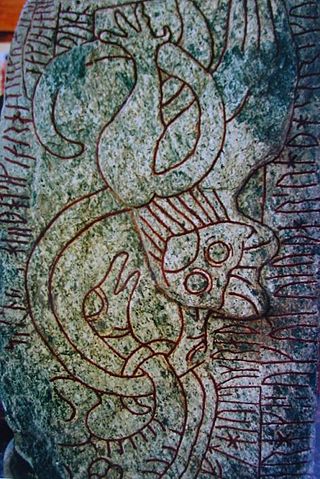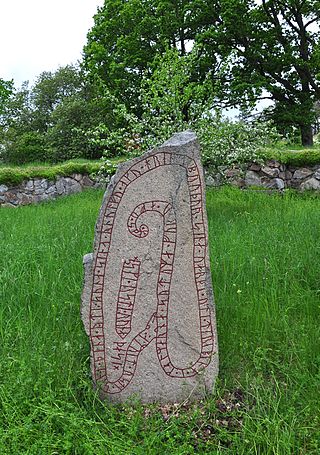
The Ardre image stones are a collection of ten rune and image stones, dated to the 8th to 11th centuries, that were discovered at Ardre Church, in Ardre, Gotland, Sweden. The principal edition is by Sune Lindqvist. [1]

The Ardre image stones are a collection of ten rune and image stones, dated to the 8th to 11th centuries, that were discovered at Ardre Church, in Ardre, Gotland, Sweden. The principal edition is by Sune Lindqvist. [1]
The Ardre image stones were re-used as paving under the wooden floors of the local church in the Ardre parish of Gotland. Before the historical significance of rune and image stones was understood or appreciated, they were often used as materials in the construction of roads, bridges, and buildings. The image stones were re-discovered when the church was being restored around 1900. The stones are now preserved in the Swedish Museum of National Antiquities in Stockholm.

The largest and most noted of the stones is the Ardre VIII stone, dated to the 8th [2] or 9th century, depicts scenes from Norse mythology, notably the Lay of Weyland the smith, Thor fishing for Jörmungandr, the punishment of Loki for the death of Baldr, [3] and Odin riding to Valhalla on Sleipnir. Other images on this stone, such as the woman on the right with two swords, are not currently understood as they do not conform to any known Norse myth that has survived to the present time. [3] The image-stone's longboat motif with its mariners somewhat resembles a depiction found on the Överhogdal tapestry No. III from Härjedalen. The main study of this stone is by Ludwig Buisson. [4]

The inscription on one of the two sides of the Ardre III runestone, which is listed in Rundata as Gotland Runic Inscription 113, consists of twin figure eight serpents with runic text in a band on the edge of the stone, while the second side has a single intertwined serpent with runic text on the edge of the stone. The inscription is classified as probably being in runestone style Pr3. The runic text, which is signed by a runemaster with the normalized name of Likraiv, indicates that it was raised as a memorial with different sponsors for the inscriptions on each side of the stone.

The Sparlösa Runestone, listed as Vg 119 in the Rundata catalog, is located in Västergötland and is the second most famous Swedish runestone after the Rök runestone.

The Jarlabanke Runestones is the name of about 20 runestones written in Old Norse with the Younger Futhark rune script in the 11th century, in Uppland, Sweden.
The Ingvar runestones is the name of around 26 Varangian Runestones that were raised in commemoration of those who died in the Swedish Viking expedition to the Caspian Sea of Ingvar the Far-Travelled.

The Granby Runestone, designated as U 337 under the Rundata catalog, is one of the longest Viking Age runic inscriptions located in Uppland, Sweden.

The Orkesta Runestones are a set of 11th-century runestones engraved in Old Norse with the Younger Futhark alphabet that are located at the church of Orkesta, northeast of Stockholm in Sweden.
The Altuna Runestone (Altunastenen), listed as U 1161 in the Rundata catalog, is a Viking Age memorial runestone with images from Norse mythology that is located in Altuna, Uppland, Sweden.
The Greece runestones are about 30 runestones containing information related to voyages made by Norsemen to the Byzantine Empire. They were made during the Viking Age until about 1100 and were engraved in the Old Norse language with Scandinavian runes. All the stones have been found in modern-day Sweden, the majority in Uppland and Södermanland. Most were inscribed in memory of members of the Varangian Guard who never returned home, but a few inscriptions mention men who returned with wealth, and a boulder in Ed was engraved on the orders of a former officer of the Guard.

The Varangian Runestones are runestones in Scandinavia that mention voyages to the East or the Eastern route, or to more specific eastern locations such as Garðaríki in Eastern Europe.

The Sigurd stones form a group of eight or nine Swedish runic inscriptions and one picture stone that depict imagery from the Germanic heroic legend of Sigurd the dragon slayer. They were made during the Viking Age and constitute the earliest Norse representations of the matter of the Völsung cycle that is the basis of the Middle High German Nibelungenlied and the Sigurd legends in the Poetic Edda, the Prose Edda, and the Völsunga saga.
The Viking runestones are runestones that mention Scandinavians who participated in Viking expeditions. This article treats the runestone that refer to people who took part in voyages abroad, in western Europe, and stones that mention men who were Viking warriors and/or died while travelling in the West. However, it is likely that all of them do not mention men who took part in pillaging. The inscriptions were all engraved in Old Norse with the Younger Futhark. The runestones are unevenly distributed in Scandinavia: Denmark has 250 runestones, Norway has 50 while Iceland has none. Sweden has as many as between 1,700 and 2,500 depending on definition. The Swedish district of Uppland has the highest concentration with as many as 1,196 inscriptions in stone, whereas Södermanland is second with 391.

Arkils tingstad is the remains of the Viking Age thing or assembly location of a hundred in Uppland, Sweden. It is situated on the outskirts of Stockholm. The remains consist of a rectangular stone formation and two runestones.

The Gällsta Runestones from the 11th century commemorate four generations of the same family in Viking Age Sweden. There are three runestones and a raised stone which is only inscribed with a cross. The runestones are located at the northern outskirts of Stockholm, just northwest of the lake Vallentunasjön, around which is found the world's greatest concentration of runestones. All the Gällsta Runestones are attributed to Öpir, the most productive of all the old runemasters.

The Manx runestones were made by the Norse population on the Isle of Man during the Viking Age, mostly in the 10th century. Despite its small size, the Isle of Man stands out with many Viking Age runestones, in 1983 numbering as many as 26 surviving stones, which can be compared to 33 in all of Norway. So many of them may appear on the Isle of Man because of the merging of the immigrant Norse runestone tradition with the local Celtic tradition of raising high crosses.

The Torsätra runestone, cataloged by Rundata as runic inscription U 614, is a Viking Age memorial runestone originally located in Torsätra, which is around 8 kilometers northeast of Bro, Stockholm County, Sweden, which is in the historic province of Uppland.

Uppland Runic Inscription Fv1946;258 or U Fv1946;258 is the Rundata catalog designation for a Viking Age memorial runic inscription to two fathers that is located in Fällbro, which is about 5 kilometers northwest of Täby, Stockholm County, Sweden, which is in the historic province of Uppland.

Uppland Runic Inscription 181 or U 181 is the Rundata catalog number for a Viking Age memorial runestone located at Össeby-Garn, which is about one kilometer east of Karby, Uppsala County, Sweden.

The Aringsås Runestones are two runestones located at the Aringsås Church in Alvesta, Kronoberg County, Sweden, which was in the historic province of Småland. A third runestone is believed to be hidden within a churchyard wall.

Uppland Runic Inscription 171 or U 171 is the Rundata catalog listing for a Viking Age memorial runestone that is located in Söderby, which is four kilometers west of Vaxholm, Stockholm County, Sweden, and in the historic province of Uppland.

The Vidbo Runestones are two Viking Age memorial runestones that are located in the churchyard of the Vidbo church, which is about 10 km (6.2 mi) east of Knivsta, Uppsala County, Sweden, in the historic province of Uppland.

The Södermanland Runic Inscription 333 is a Viking Age runestone engraved in Old Norse with the Younger Futhark runic alphabet. It is located at the abandoned Ärja Church in Strängnäs Municipality. The style of the runestone is a categorized as Fp.